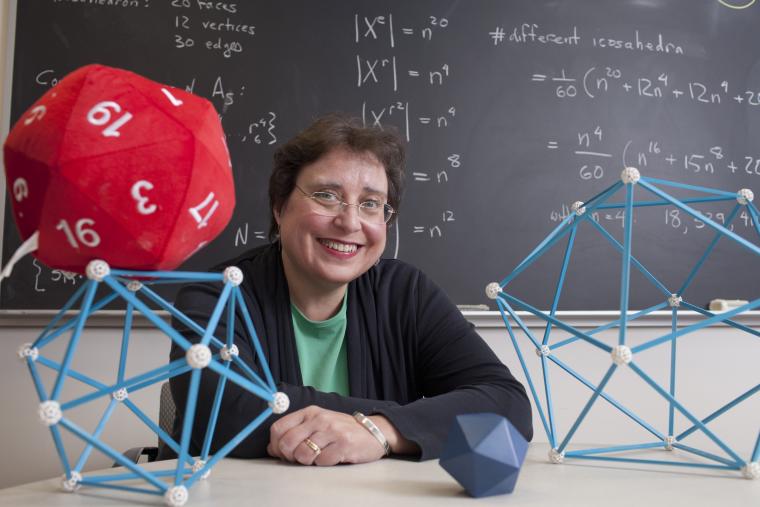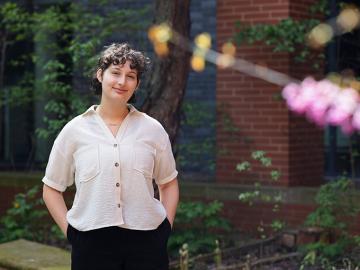Top of Her Game
September 10, 2015
Amanda Nagy

Andrew and Pauline Delaney Professor of Mathematics Susan Colley has spent the last 32 years staying on top of her field to train new generations of Oberlin students.
An expert in the field of algebraic geometry, Colley focuses on a subfield called enumerative geometry, in which the goal is to be able to count geometric configurations.
To the uninformed, mathematics may not seem to be an ever-changing, rapidly developing discipline, but it is.
“When I think of my own field that I trained in as a graduate student, I joke that I’ve had to relearn my own specialty three times,” she says. “In the late ’90s, there were new techniques that came from string theory. I had to learn that; then, about 10 years ago another strain of mathematics became important, and I had to learn it again.”
For mathematicians, the prevailing view used to be that by the time you were 40, you’d never make another contribution because mathematics was only for young people—men, actually.
“That’s certainly a myth, but, like any academic discipline, it takes a lot of energy and concentration to stay current with developments,” says Colley, whose own contributions have earned recognition for her in the form of a significant new opportunity to serve the mathematics community: She has been appointed editor-elect of the American Mathematical Monthly, the flagship journal of the Mathematical Association of America. The Monthly is the most widely read journal in the math community. For Colley, the position is a defining moment in her career.
“This is very exciting. It’s almost a career change, and it’s portrayed as essentially a full-time job. It’s going to call upon whatever skills I have, and I’m going to be forced to develop some new ones. It’s going to be interesting to see how I can do creative things with work that is coming from other people.”
As editor, Colley will manage production, set the editorial tone, and vet all the submitted articles to determine what to accept or reject for publication. The Monthly is a unique publication in that it’s not exclusively a research publication, she explains.
“It does publish new research, but it emphasizes high-quality exposition and broad appeal. It’s very hard in mathematics to make high-level research accessible to a broad population of mathematicians. It marries really interesting and frequently very new mathematics with exposition that makes it accessible, primarily to collegiate mathematicians.”
Colley will remain on the faculty throughout her year as editor-elect and subsequent five-year term as editor-in-chief, but she will reduce her teaching commitments beginning in spring 2016. She says the position comes at a good time in her career. As she reflects on her years of teaching, the driving force has always been her passion and enthusiasm for mathematics.
“What I love about mathematics is that it’s not that any technique really ever gets thrown out, it’s that you just keep adding on to those techniques. What’s wonderful to me is that even if something becomes less fashionable, it has a way of coming back. I teach a course in computational algebra, and many of the ideas are 19th century mathematics that got abandoned because you couldn’t compute with them by hand anymore. And sure enough, starting in about the ’70s and ’80s, the ideas came back because now we could give the problems over to computers.
“It’s fun to talk about mathematics that I know well. It balances with research, which concerns mathematics that I am just learning myself. I don’t get tired of thinking about the same ideas and showing them to a new group of people and finding a good way to explain them. At Oberlin, I think the students I can add value to are the ones who are very good but might be shy or aren’t assertive. The very best students will flourish wherever they go, but we can take the very good students and convince them that they will do well in a mathematical career, even when they don’t yet see it in themselves.”
About the MAA
The Mathematical Association of America is the largest professional society that focuses on making mathematics accessible at the undergraduate level. Formed in 1915, the association has members that include university, college, and high school teachers; graduate and undergraduate students; pure and applied mathematicians; computer scientists; statisticians; and many others in academia, government, business, and industry who are interested in the mathematical sciences.
Tags:
You may also like…
Oberlin Researchers Part of Breakthrough Study on Gravitational Waves
June 29, 2023
Fifteen-year NSF-funded project involves dozens of students past and present, provides evidence of Einstein’s theory of relativity.
Fins to the Left (and Right)
May 25, 2023
Biology major Jules Lieberman to study shark and ray migratory patterns through NOAA Hollings Scholarship.
Keith Tarvin Earns Excellence in Teaching Award
May 18, 2023
A scholar in the fields of evolution, behavioral ecology, ornithology, and organismal biology, Tarvin was honored for his approach to teaching and mentoring undergraduate researchers.


